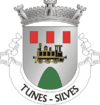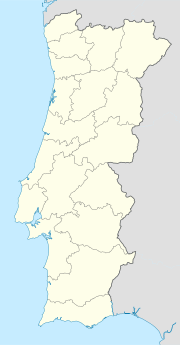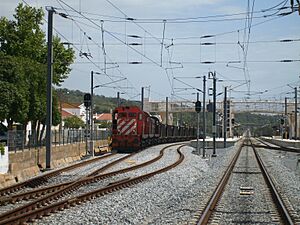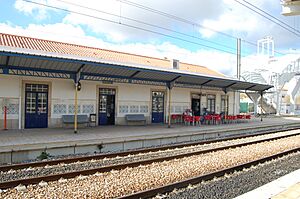Tunes (Silves) facts for kids
Quick facts for kids
Tunes
|
||
|---|---|---|
|
Civil parish
|
||
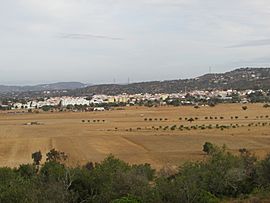
Vista of Tunes from the south
|
||
|
||
| Country | ||
| Region | Algarve | |
| Intermunic. comm. | Algarve | |
| District | Faro | |
| Municipality | Silves | |
| Disbanded | 2013 | |
| Area | ||
| • Total | 12.8 km2 (4.9 sq mi) | |
| Elevation | 66 m (217 ft) | |
| Population
(2001)
|
||
| • Total | 2,002 | |
| • Density | 156.4/km2 (405.1/sq mi) | |
| Time zone | WET/WEST (UTC+0/+1) | |
| Postal code |
8365-235
|
|
| Area code | 282 | |
| Website | http://www.jf-tunes.com | |
Tunes is a village in Portugal. It is located in the Algarve region, within the Silves municipality. It is part of the civil parish of Algoz e Tunes.
Until 2013, Tunes was its own civil parish. Then, it joined with Algoz to form the new parish of Algoz e Tunes. In 2001, about 2,002 people lived in Tunes. The area was around 12.13 square kilometres (4.68 sq mi). This meant there were about 167 residents per square kilometer. Tunes is a very important place for trains in southern Portugal.
History of Tunes
Many people believe the name Tunes comes from North Africa. They think it was named after settlers from Tunis. These people often point to a flower called the French marigold (Tagetes patula). This flower is common in both Tunes, Portugal, and Tunisia. It looks a bit like a carnation with yellow petals.
How Tunes Was Formed
The civil parish of Tunes was officially created on October 4, 1985. This made it the newest parish in Silves at the time. The village grew mainly because of the railway lines. These lines connected Lisbon to the Algarve region.
The Railway's Impact
In the 1800s, Tunes was mostly a farming area. Farmers grew grapes to make wine. The first neighborhoods started to appear after the railway opened in Gateiras. The original plan was to build a train station in Algoz, near Tunes. However, because of the hilly land, the station was built a few kilometers to the east instead.
Many people who lived in Tunes worked for the railway. On February 21, 1889, the first train traveled through Tunes. This was on the main line connecting Lisbon to Faro. The last steam-powered train in the Algarve also ran on this line, specifically between Tunes and Lagos, in 1972.
Modern Changes
Also in 1972, the first power plant was opened in the community. Over time, the economy of Tunes changed. It went from being focused on farming and industry to being more about tourism.
Geography of Tunes
Tunes is located about 29.7 kilometres (18.5 mi) east of the main town of Silves. It is also about 245 kilometres (152 mi) south-southeast of Lisbon.
The area includes several smaller places. These are Amêndoais, Assumadas, Canais da Silva, Cortezães, Gateiras, Guiné, Poço da Figueira, and Tunes itself. The village is most famous for its train station. This station is a very important transport hub for the entire country.
Buildings and Structures
Important Civic Buildings
- Primary School of Tunes: This is the main school for children in the area.
- Railway Station of Tunes: This historic train station is a key part of the village's identity.
Notable People from Tunes
Diogo do Guiné
Diogo do Guiné was a person known for avoiding the police in 1833. He found a safe place in a cave in Cerro do Guiné. People were afraid to try and catch him there. This was because other people who were also avoiding the law lived in the caverns. Because of this, the cave and the area became known as Diogo do Guiné.
Hermínio da Palma Inácio
Hermínio da Palma Inácio was born in Ferragudo, Lagoa, on January 29, 1922. He passed away in Lisbon on July 14, 2009. He was from Tunes and became well-known for his actions against the government of António Oliveira de Salazar.
One famous event was when he took control of a TAP airplane in 1961. The plane was flying from Casablanca to Lisbon. He also helped start a group called LUAR – Liga de União Revolucionária (League of Revolutionary Union). In 1995, after he passed away, the Portuguese President Mário Soares gave him a special award called the Order of Liberty.
See also
 In Spanish: Tunes para niños
In Spanish: Tunes para niños


